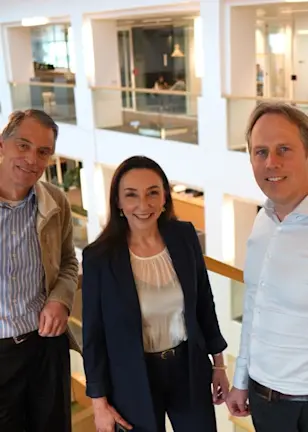免責聲明
1. 一般事項
請細閱以下資料。
此網站由Robeco Hong Kong Limited(「荷寶」)擬備及刊發,荷寶是獲香港證券及期貨事務監察委員會發牌從事第1類(證券交易)、第4類(就證券提供意見)及第9類(資產管理)受規管活動的企業。荷寶不持有客戶資產,並受到發牌條件所規限。荷寶在擴展至零售業務之前,必須先得到證監會的批准。本網頁未經證券及期貨事務監察委員會或香港的任何監管當局審閱。
2. 風險披露聲明
Robeco Capital Growth Funds以其特定的投資政策或其他特徵作識別,請小心閱讀有關Robeco Capital Growth Funds的風險:
部份基金可涉及投資、市場、股票投資、流動性、交易對手、證券借貸及外幣風險及小型及/或中型公司的相關風險。
部份基金所涉及投資於新興市場的風險包括政治、經濟、法律、規管、市場、結算、執行交易、交易對手及貨幣風險。
部份基金可透過合格境外機構投資者("QFII")及/或 人民幣合格境外機構投資者 ("RQFII")及/或 滬港通計劃直接投資於中國A股,當中涉及額外的結算、規管、營運、交易對手及流動性風險。
就分派股息類別,部份基金可能從資本中作出股息分派。股息分派若直接從資本中撥付,這代表投資者獲付還或提取原有投資本金的部份金額或原有投資應佔的任何資本收益,該等分派可能導致基金的每股資產淨值即時減少。
部份基金投資可能集中在單一地區/單一國家/相同行業及/或相同主題營運。 因此,基金的價值可能會較為波動。
部份基金使用的任何量化技巧可能無效,可能對基金的價值構成不利影響。
除了投資、市場、流動性、交易對手、證券借貸、(反向)回購協議及外幣風險,部份基金可涉及定息收入投資有關的風險包括信貨風險、利率風險、可換股債券的風險、資產抵押證券的的風險、投資於非投資級別或不獲評級證券的風險及投資於未達投資級別主權證券的風險。
部份基金可大量運用金融衍生工具。荷寶環球消費新趨勢股票可為對沖目的及為有效投資組合管理而運用金融衍生工具。運用金融衍生工具可涉及較高的交易對手、流通性及估值的風險。在不利的情況下,部份基金可能會因為使用金融衍生工具而承受重大虧損(甚至損失基金資產的全部)。
荷寶歐洲高收益債券可涉及投資歐元區的風險。
投資者在Robeco Capital Growth Funds的投資有可能大幅虧損。投資者應該參閱Robeco Capital Growth Funds之銷售文件內的資料﹙包括潛在風險﹚,而不應只根據這文件內的資料而作出投資。
3. 當地的法律及銷售限制
此網站僅供“專業投資者”進接(其定義根據香港法律《證券及期貨條例》(第571章)和/或《證券及期貨(專業投資者)規則》(第571D章)所載)。此網站並非以在禁止刊發或提供此網站(基於該人士的國籍、居住地或其他原因)的任何司法管轄區內的任何人士為對象。受該等禁例限制的人士或並非上述訂明的人士不得登入此網站。登入此網站的人士需注意,他們有責任遵守所有當地法例及法規。一經登入此網站及其任何網頁,即確認閣下已同意並理解以下使用條款及法律資料。若閣下不同意以下條款及條件,不得登入此網站及其任何網頁。
此網站所載的資料僅供資料參考用途。
在此網站發表的任何資料或意見,概不構成購買、出售或銷售任何投資,參與任何其他交易或提供任何投資建議或服務的招攬、要約或建議。此網站所載的資料並不構成投資意見或建議,擬備時並無考慮可能取得此網站的任何特定人士的個別目標、財務狀況或需要。投資於荷寶產品前,必須先細閱相關的法律文件,例如管理法規、基金章程、最新的年度及半年度報告,所有該等文件可於www.robeco.com/hk/zh免費下載,亦可向荷寶於香港的辦事處免費索取。
4. 使用此網站
有關資料建基於特定時間適用的若干假設、資料及條件,可隨時更改,毋需另行通知。儘管荷寶旨在提供準確、完整及最新的資料,並獲取自相信為可靠的資料來源,但概不就該等資料的準確性或完整性作出明示或暗示的保證或聲明。
登入此網站的人士需為其資料的選擇和使用負責。
5. 投資表現
概不保證將可達到任何投資產品的投資目標。並不就任何投資產品的表現或投資回報作出陳述或承諾。閣下的投資價值可能反覆波動。荷寶投資產品的資產價值可能亦會因投資政策及/或金融市場的發展而反覆波動。過去所得的業績並不保證未來回報。此網站所載的往績、預估或預測不應被視為未來表現的指示或保證,概不就未來表現作出任何明示或暗示的陳述或保證。基金的表現數據以月底的交易價格為基礎,並以總回報基礎及股息再作投資計算。對比基準的回報數據顯示未計管理及/或表現費前的投資管理業績;基金回報包括股息再作投資,並以基準估值時的價格及匯率計算的資產淨值為基礎。
投資涉及風險。往績並非未來表現的指引。準投資者在作出任何投資決定前,應細閱相關發售文件所載的條款及條件,特別是投資政策及風險因素。投資者應確保其完全明白與基金相關的風險,並應考慮其投資目標及風險承受程度。投資者應注意,基金股份的價格及收益(如有)可能反覆波動,並可能在短時間內大幅變動,投資者或無法取回其投資於基金的金額。若有任何疑問,請諮詢獨立財務及有關專家的意見。
6. 第三者網站
本網站含有來自第三方的資料或第三方經營的網站連結,而其中部分該等公司與荷寶沒有任何聯繫。跟隨連結登入任何其他此網站以外的網頁或第三方網站的風險,應由跟隨該連結的人士自行承擔。荷寶並無審閱此網站所連結或提述的任何網站,概不就該等網站的內容或所提供的產品、服務或其他項目作出推許或負上任何責任。荷寶概不就使用或依賴第三方網站所載的資料而導致的任何虧損或損毀負上法侓責任,包括(但不限於)任何虧損或利益或任何其他直接或間接的損毀。 此網站以外的網頁或第三方網站皆旨在作參考之用。
7. 責任限制
荷寶及(潛在的)其他網站資料供應商概不就此網站內容或其所載的資料或建議負責,而該等內容、資料或建議可予更改,毋需另行通知。
荷寶並無責任確保及保證此網站的功能將不受干擾或並無失誤。荷寶概不就有關荷寶(交易)服務電郵訊息的後果承擔任何責任,該等電郵訊息可能無法接收或發出、損毀、不正確接收或發出或並無準時接收或發出。
荷寶亦不就因登入及使用此網站而可能導致的任何虧損或損毀負責。
8. 知識產權
所有版權、專利、知識產權和其他財產,以及有關此網站資料的授權均由荷寶持有及獲取。該等權利不會轉授予查閱有關資料的人士。
9. 私隠
荷寶保證將會根據現行的資料保障法例,以保密方式處理登入此網站的人士的數據。除非荷寶需按法律責任行事,否則在未經登入此網站的人士許可,不會向第三方提供該等數據。 請於我們的私隱及Cookie政策 中查找更多詳情。
10. 適用法律
此網站受香港法律監管及據此解釋。因此網站導致或有關此網站的所有爭議應交由香港法庭作出專有裁決。
如果您已閱讀並理解本頁並同意上述免責聲明以及同意荷寶收集和使用您的個人資料,用於私隱及Cookie政策 所列的收集和使用個人資料的目的(包括用於直接推廣荷寶的產品或服務),請點擊“我同意”按鈕。否則,請點擊“我不同意”離開本網站。
Climate investing
Solutions
The solution to climate change can be summed up in one word – decarbonize. Investors serious about climate therefore need to look for net zero solutions. Robeco offers climate-orientated investment strategies; from bespoke net zero funds to more thematic strategies targeting renewable energy and the technology behind it, we’re at the forefront of making the world more sustainable.

Robeco’s Global Climate Survey of 2024 showed that the number of investors globally who have made a firm commitment to net zero remained constant at 25%, rising to 37% of European investors. Commitments in Asia-Pacific rose to 26% of investors, up from 20% in 2023. Some 17% of global investors said they were in the process of evaluating a net zero commitment, and a further 27% were investigating whether it would work for their portfolios. However, interest in North America has declined due to a backlash against ESG investing generally.
There is both the appetite for making a difference and a wealth of solutions available. These fall broadly into four main categories:
Bespoke climate funds that specifically target the equities of companies that can combat global warming, from those in renewable energy and emissions reduction technology to those in related topics such as biodiversity.
Decarbonization funds linked to Paris-aligned benchmarks that look to reduce the carbon footprint of existing high-emitting investments by the 7% a year required to achieve net zero by 2050. These include companies that are currently part of the problem, but which can change to become part of the solution.
Thematic investments that look for wider and more holistic solutions to create a more sustainable world, such as sustainable water, the circular economy, and the ‘smart’ way to look at future energy, mobility and materials. These are explained in more detail below.
Funds that look for companies making contributions to the Sustainable Development Goals (SDGs), one-third of which are directly related to combating climate change, such as SDG 12 (responsible consumption and production).
The sustainable transition
Sustainable transition signifies the biggest intentional change for people and our planet in history. Transition investing targets companies who may be at the beginning of this journey to improve human well-being and combat climate change. This provides numerous investment opportunities. We use forward-looking metrics to identify companies with sustainable potential, and offer investment solutions to seize these opportunities.
How we can generate alpha
In order to navigate the transition investment landscape and generate alpha, we need to understand the direction of travel and identify the winners and losers in this dynamic process. There is a broad universe to assess, as transition investing targets companies who may be at the beginning of their decarbonization journeys.
While regulation is currently driving transition momentum, this journey is set to last several decades. Any company currently preparing for a low-carbon future will have a significant advantage over those that are not. Our investment process recognizes the multiple dimensions of the transition to create robust and resilient investment solutions that understand both the complexity and the longevity of this transition – all with our eyes on the prize of generating alpha.
The transition is about the future and the ability to navigate changing environments - regulatory or otherwise. Both public and private markets are needed to make this happen. Choosing the right investments requires us to develop clear frameworks that embrace the dynamic and multi dimension of transition.
Making it investible
The challenge for professional investors lies in translating transition concepts into investable portfolio assets. This requires a hard look at who qualifies, and on what grounds. As always, getting hold of the right research and data is crucial to find the transition champions.
How companies are deploying and using their capital expenditures to finance a more sustainable future is key. Robeco has decades of experience in understanding just that and making the right investment calls. It’s essential to acquire as much forward-looking data as possible. Emissions data is a good way to track progress, but it is backward-looking. Our SI teams have developed research frameworks that aim to predict future patterns rather than past. Plotting future moves is a new frontier for most asset managers, but Robeco has decades of experience in developing and refining its sustainable investing practices.
Global opportunity, Asia sets the pace
The sustainable transition presents a worldwide opportunity, yet the forefront of combating climate change lies predominantly within Asia. Asia accounts for half of the world’s greenhouse gas emissions and is home to about 60% of the global population. Despite the acute need for Asia’s transition, flows toward these investments have been hampered by limited applicable standards, considering the consider the region’s diverse geographical and economic challenges.
That’s why our emerging markets teams specifically look at Asia, and from a ringside seat from Robeco’s offices in Hong Kong, Shanghai and Singapore. Our local expertise can identify solutions, such as using corporate bonds and green bonds to direct capital to the right places. This doesn’t mean the rest of the world can rest on its laurels. Globally, all companies need to create their own business ecosystems that will help them find their path toward climate‐resilient development.
Climate investing is more than just the next big thing
Lucian Peppelenbos (Climate Strategist) and Carola van Lamoen (Head of Sustainable Investing) look at climate change and climate investing from all angles. Listen to the trailer or to the full 25-minute podcast.
The planet’s growing but resources are shrinking
From field to fork, smart farming uses technology to optimize resources, improve yields, reduce waste, conserve biodiversity and increase food security across the food value chain. Our Sustainable Water and Circular Economy Equities strategies invest in companies focused on applying technological advancements that target depleting water supplies as well as smart farming techniques for soil and crop management.
More people, less land, less water
The UN estimates that by 2050 human populations will grow to 9.7 billion. That means more than 65 million additional mouths need feeding every year, adding pressure on food and agricultural sectors to produce more to keep pace. Moreover, land is getting even scarcer as populations and cities expand exponentially. The number of megacities – defined as having more than 10 million inhabitants – is increasing worldwide, particularly in developing markets.
Land is not the only critical resource in short supply. As populations boom, so does their water consumption. Global water demand already exceeds supply, with two billion people currently living in areas of acute water stress.
Moreover, water withdrawals are dominated by the agricultural sector, as the water used to produce food is exponentially more than what is used for personal consumption. To illustrate, just one apple requires more than 70 liters of water to produce.
Worldwide, dietary habits are shifting from staples such as roots, tubers and cereal grains towards animal proteins like meat and dairy that demand exponentially greater inputs of water and other resources. Though some of these shifts are healthy and desirable, they are also resource-intensive and costly and intensify pressure on water supplies. For example, producing one kilogram of beef requires 15,000 liters of water.
Environmental challenges
To super-charge crop yields, industrial agriculture has turned to synthetic fertilizers, herbicides and pesticides to stimulate and protect plant growth. However, while effective at improving yields in the short-term, they have also had disastrous long-term effects on the surrounding land and ecosystems. Excess chemicals seep down into natural aquifers and flow into streams, rivers, lakes and ponds, killing native plant species and wildlife.
Moreover, farming and agriculture is acutely vulnerable to the damaging effects of global warming. In some regions, crops are lost to over-precipitation and flooding, whereas in other areas crops suffer due to heat waves and drought. Farmers need to adapt at an accelerated pace to avert crop damage and lost harvests. At the same time, to feed the world without damaging the planet, farmers need to optimize resources and develop climate-smart agricultural practices so that productive and resilient agriculture can be achieved.
Increasing supply, protecting quality
Robust water supplies are essential for agricultural productivity. Our Sustainable Water strategy invests in companies providing solutions to maximize water resources across the water extraction and reuse cycle. In areas of water scarcity, portfolio companies are developing methods to secure water from surrounding environment. Many land-locked countries are investing in technologies to capture and clean rainwater. At the other extreme, arid countries with access to ocean waters are investing in desalination plants. Wastewater purification via microfiltration membranes and ultraviolet light are also effective technologies helping regions to counter chronic water shortages.
Furthermore, to transport water to fields and farms, efficient networks of pumps, pipes valves and irrigation systems are needed. Thanks to digitalization, these networks and systems are being equipped with sensors that rapidly detect leaks and breaks, monitor soil moisture levels, and customize water doses according to soil need. In addition, advances in water treatment and analytics are helping identify and extract chemicals, fertilizers, and contaminants from waste and run-off water so that it can be safely returned to the environment or recycled back into the system.
Finally, the importance of water extends beyond hydrating and nourishing crops. Improving soil’s water retention helps restore organic matter and reduce erosion. This leads to more nutritious crops and healthier livestock.
From plants to plates
Ensuring safe water supplies isn’t the only approach to sustainable agriculture. From plants to plates, our Circular Economy strategy is investing in solutions that increase efficiencies across farming and food systems. Smart farming’s focus on reducing inputs and protecting soils and vegetation makes it an area ripe for application of circularity principles. GPS technology is already widely used to navigate tractors and harvesters, reducing costs and CO2 emissions associated with operating farming machinery.
Moreover, AI and machine learning can teach agricultural equipment to detect weeds in fields and to automatically apply crop protection chemicals with unprecedented precision and accuracy.
As a result, the volume of chemicals required can be reduced by up to 90%, significantly protecting biodiversity without compromising crop yields.
Population growth, scarce resources and climate change are straining the agricultural sector as well as the environment. Our Sustainable Water and Circular Economy investment strategies are helping address these challenges by providing solutions that are not only effective and efficient for crops and livestock, but also beneficial for all life on the planet.
Thematic Investing
Targeted, real-world solutions to global sustainability challenges
We believe that addressing global sustainability challenges offers a significant, long-term value proposition. Climate change, resource scarcity, endangered biodiversity as well as unhealthy lifestyles are all examples of real-world obstacles that reduce society's optimal growth and development.

Clean electrification to drive the global economy to net zero
Getting to net zero in the 21st century and mitigating climate disaster require industry to shift gears, switch fuels and change course.
The expansion of renewables is a powerful catalyst that is enabling the development of clean technologies and solutions across the energy value chain. Mass deployment of solar and wind- power is helping decarbonize electricity generation, and intelligent electrical grids ensure energy demand always matches supply. Grid-connected batteries and green hydrogen will ensure surplus electricity is stored for later use. Moreover, the clean electrification of heavy-carbon emitting areas like passenger mobility, transport logistics and building heat are already underway and gaining momentum.
As electrification spreads and demand for electricity increases, the energy generated will need to be consumed efficiently. Next-generation technologies are helping to reduce energy consumption in power-hungry applications and end-user devices in buildings, industrials, transportation and IT sectors.
Our Smart Energy and Smart Mobility strategies invest across the clean energy and transportation value chains, providing investors diversified exposure to the megatrends of decarbonization and sustainable mobility.
Energy meets urgency
Populations and economies need energy. Unfortunately, primary energy supplies are still dominated by hydrocarbons, and global carbon emissions continue to rise. The urgency of climate change has propelled efforts to “green” the global economy, triggering disruptive innovation that is rapidly altering the energy landscape.
Governments worldwide have announced massive new initiatives aimed at decarbonizing entire economies. Prominent among them are strong commitments from the US and China, which are finally aligned with global ambitions to tackle climate change.
Front and center in the race to decarbonize is the carbon-free electricity provided by renewables. Internal projections show that by 2050, solar power generation is likely to increase by a factor of 20, while wind power generation from on and off-shore sources will increase by a factor of 10. This will allow the share of electricity as a percent of global energy consumption to grow from 20% today to 50% by 2050. In parallel, renewables’ share of the electricity mix will nearly triple.
Electrification of transport
The electrification of the transport sector has already developed considerable momentum in recent years and will continue to be an important theme for energy-related investments. Electric vehicle (EV) sales have risen sharply in key markets like Europe and China and should remain strong. Again, internal estimates show global EV sales in 2021 nearly doubling from 2020 which was already an extraordinary year marked by 130% year-on-year growth in Europe and a significant rebound in China towards year end.
The strategies’ investments in transportation are not limited to EV producers; they also cover a whole range of ancillary companies within the EV ecosystem that supply essential parts such as power semiconductors, battery storage, sensors and actuators, as well as EV charging infrastructure.
Electrification of the built environment
Transport is not the only high-emission sector being transformed by electrification; the built environment is also in transition. According to the International Energy Agency, buildings and building construction combined are responsible for over a third of final energy consumption globally and nearly 40% of direct and indirect carbon emissions.
Driven by stricter emission standards and the prospect of lower energy costs, commercial buildings are turning to clean electrification to power and regulate everything from heat pumps and cooling to energy-efficient lighting and building management systems.
Green hydrogen – the missing link
The trend towards electrification is also driving other essential parts of the energy equation. Solar and wind power are clean but also weather dependent and intermittent. Cheap solutions must be created to temporarily store any surplus energy generated. Within passenger transport, lithium ion batteries within electric vehicles are providing cost-effective energy storage solutions; and further improvements are on the horizon.
Larger-scale industries are more energy intensive and difficult to electrify, but even here clean solutions are emerging. Green hydrogen is created by splitting water into hydrogen fuel and oxygen using carbon-free electricity from renewables. As it scales and becomes more cost-competitive, it will provide a critical link in decarbonizing high-carbon emitting industries like long-haul transportation (e.g. trucks, trains, ships and aircraft) and industrial sectors (e.g. semiconductors, fertilizers, and steel production).
Powering up an investment portfolio
Decarbonization of energy goes well beyond the production of solar panels and wind turbines. Reaching net zero in this century will require transformation across the entire energy value chain.
Our Smart Energy and Smart Mobility strategies give investors diversified exposure to these long-term investment trends that are transforming the energy sector and moving us closer to a carbon-neutral future. The Smart Materials fund specializes in the compounds that are fueling (in a greener way) the transition.

Green Bonds
Leveraging a five-step proprietary process to mitigate greenwashing while creating a positive impact
A green bond is a bond that is specifically earmarked to raise money for climate and environmental projects. This strategy has been very successful with issuance over USD 1 trillion between 2015-2022. However, the term ‘green bond’ is not legally protected. That’s why Robeco uses a proprietary framework to select truly green bonds for its strategy.
















